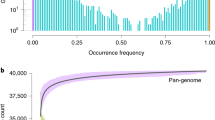Abstract
The process of crop domestication occurs through the selection and subsequent propagation of novel alleles that improve traits of interest. Cultivated tomato (Solanum lycopersicum), particularly heirloom varieties, exhibit a wide range of variation in fruit size, shape and color. The green-flesh mutant of tomato possesses a stay-green phenotype resulting in fruits that ripen to a red-brown color, due to the retention of chlorophyll and the simultaneous accumulation of lycopene. The recent identification of the GREEN-FLESH gene provides a molecular tool with which to investigate the origin of a subset of cultivated tomato varieties that resemble the green-flesh mutant. Sequence analysis of the GF locus from 26 varieties revealed the existence of four previously unidentified null alleles. This study illustrates the potential of cultivated tomato varieties, including heritage cultivars, heirlooms, and land races, for uncovering new alleles in genes of interest.



Similar content being viewed by others
References
Akhtar MS, Goldschmidt EE, John I, Rodoni S, Matile P, Grierson D (1999) Altered patterns of senescence and ripening in gf, a stay-green mutant of tomato (Lycopersicon esculentum Mill.). J Exp Bot 50:1115–1122. doi:10.1093/jexbot/50.336.1115
Armstead I, Donnison I, Aubry S, Harper J, Hortensteiner S, James C, Mani J, Moffet M, Ougham H, Roberts L, Thomas A, Weeden N, Thomas H, King I (2006) From crop to model to crop: identifying the genetic basis of the staygreen mutation in the Lolium/Festuca forage and amenity grasses. New Phytol 172:592–597. doi:10.1111/j.1469-8137.2006.01922.x
Armstead I, Donnison I, Aubry S, Harper J, Hortensteiner S, James C, Mani J, Moffet M, Ougham H, Roberts L, Thomas A, Weeden N, Thomas H, King I (2007) Cross-species identification of Mendel’s/locus. Science 315:73. doi:10.1126/science.1132912
Barry CS, McQuinn RP, Thompson AJ, Seymour GB, Grierson D, Giovannoni JJ (2005) Ethylene insensitivity conferred by the Green-ripe and Never-ripe 2 ripening mutants of tomato. Plant Physiol 138:267–275. doi:10.1104/pp.104.057745
Barry CS, McQuinn RP, Chung M-Y, Besuden A, Giovannoni JJ (2008) Amino acid substitutions in homologs of the STAY-GREEN protein are responsible for the green-flesh and chlorophyll retainer mutations of tomato and pepper. Plant Physiol 147:179–187. doi:10.1104/pp.108.118430
Borovsky Y, Paran I (2008) Chlorophyll breakdown during pepper fruit ripening in the chlorophyll retainer mutation is impaired at the homolog of the senescence-inducible stay-green gene. Theor Appl Genet 117:235–240. doi:10.1007/s00122-008-0768-5
Cheung A-Y, McNellis T, Piekos B (1993) Maintenance of chloroplast components during chromoplast differentiation in the tomato mutant green flesh. Plant Physiol 101:1223–1229
Darby LA (1978) Isogenic lines of tomato fruit color mutants. Hortic Res 18:73–84
Kerr EA (1956) Green flesh, gf. Rpt Tomato Genet Coop 6:17
Konieczny A, Ausubel FM (1993) A procedure for mapping Arabidopsis mutations using codominant ecotype-specific PCR-based markers. Plant J 4:403–410. doi:10.1046/j.1365-313X.1993.04020403.x
Male CJ (1999) 100 heirloom tomatoes for the American garden. Workman Publishing, New York
Paran I, van der Knaap E (2007) Genetic and molecular regulation of fruit and plant domestication traits in tomato and pepper. J Exp Bot 58:3841–3852. doi:10.1093/jxb/erm257
Park SY, Yu JW, Park JS, Li J, Yoo SC, Lee NY, Lee SK, Jeong SW, Seo HS, Koh HJ, Jeon JS, Park YI, Paek NC (2007) The senescence-induced staygreen protein regulates chlorophyll degradation. Plant Cell 19:1649–1664. doi:10.1105/tpc.106.044891
Ren GD, An K, Liao Y, Zhou X, Cao YJ, Zhao HF, Ge XC, Kuai BK (2007) Identification of a novel chloroplast protein AtNYE1 regulating chlorophyll degradation during leaf senescence in Arabidopsis. Plant Physiol 144:1429–1441. doi:10.1104/pp.107.100172
Sato Y, Morita R, Nishimura M, Yamaguchi H, Kusaba M (2007) Mendel’s green cotyledon gene encodes a positive regulator of the chlorophyll-degrading pathway. Proc Natl Acad Sci USA 104:14169–14174. doi:10.1073/pnas.0705521104
Acknowledgments
This research was supported through start-up funds from Michigan State University and the Michigan Agricultural Experiment Station to C.B.
Author information
Authors and Affiliations
Corresponding author
Rights and permissions
About this article
Cite this article
Barry, C.S., Pandey, P. A survey of cultivated heirloom tomato varieties identifies four new mutant alleles at the green-flesh locus. Mol Breeding 24, 269–276 (2009). https://doi.org/10.1007/s11032-009-9289-4
Received:
Accepted:
Published:
Issue Date:
DOI: https://doi.org/10.1007/s11032-009-9289-4



